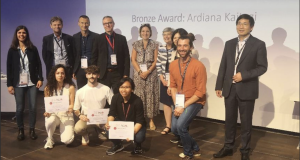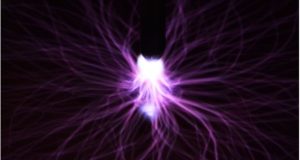Since 1950, till 2015, humans have produced approximately 8.3 billion metric tons (MT) of plastic and half of it was produced in recent years. This weight is equivalent to 1 billion elephants. If this sentence does not concern you, let me break it down a bit more. From the whole production waste (~6.3 billion MT), only 9% goes to recycling, 12% is incinerated, and 79% ends up in the ocean, landfills etc. where it disintegrates into microplastics and finally pollutes water, air, marine wildlife and it is a potential harm to humans [1].
My name is Ardiana Kajtazi, a PhD student from Ghent University, and you are reading the InnovEOX blog from ESRs.
How did everything start?
Let us go back to 1907 in Yonkers, New York, when Bakelite was invented. Bakelite or polyoxybenzylmethylenglycolanhydride (not just a nightmare name for a dyslexic person like me) was the first synthetic plastic developed by the Belgian-American chemist Leo Baekeland, who obtained his PhD in Chemistry at Ghent University where he was also a professor for several years before moving to New York [2][3]. The properties of Bakelite such as quickly molding, electrical nonconductivity and heat resistance, were revolutionary at the time; not just for radio and telecommunication and the automobile and electrical industry, but also for all sorts of products such as toys, kitchenware, buttons, jewelry, etc. (Figure 1.). This was marked as the beginning of the global plastic industry and from then on production has been rapidly increasing and causing a big environmental problem [3], [4].
![Figure 1. Bakelite products: (Left) Hawkette camera by Kodak (1927) and Motorola radio (middle) [3]; (Right) Chemical structure of Bakelite (C6H6O-CH2OH)n .](https://innoveox.eu/wp-content/uploads/2020/12/Picture-1.png)
Figure 1. Bakelite products: (Left) Hawkette camera by Kodak (1927) and Motorola radio (middle) [3]; (Right) Chemical structure of Bakelite (C6H6O-CH2OH)n .
What is microplastic?
Plastic is an artificially made material, and that is why we call it a synthetic compound. It is a polymer derived from oil, gas, or coal. We can find plastic everywhere around us. Most of it ends up in the environment and breaks up into very small solid particles, called microplastic (MPs). They are defined as small fragments of plastic that are no greater than 5mm (≤5mm) [5]. The term MP was first introduced by marine biologist Professor Richard C. Thomson from the University of Plymouth, UK [6]. There are two categories of MP: Primary and secondary. Primary are considered intentionally produced and usually come from products such as cosmetics, laundry products, toothpaste etc. that are being washed into wastewater systems. Whereas Secondary MP is a result of slow degradation of larger plastic waste affected by photo-oxidative processes (UV-light from the sun, wind abrasion, wave action) and to a lower extent biodegradation causing fragmentation into smaller pieces [5], [7].
![Figure 2. (Top) MPs affect aquatic environments via a number of processes (physical, chemical, biological) [5]; (Bottom) Their potential harm to humans and exposure routes [7].](https://innoveox.eu/wp-content/uploads/2020/12/Picture-2.png)
Figure 2. (Top) MPs affect aquatic environments via a number of processes (physical, chemical, biological) [5]; (Bottom) Their potential harm to humans and exposure routes [7].
With all this being said, what concerns me the most is how this also affects our freshwater system and the food we eat. As aforementioned, MPs are all around us and they have not just been detected in marine animal tissues, but also in human tissue and various organs. This is clearly a consequence of ingesting food and water containing MPs, but it can also be a result of being exposed to cosmetics, medicine, synthetic clothes etc. which we introduce into our body via inhalation or skin absorption (Figure 2.) [5], [7]. Many sources are showing that the percentage of MP in tap water is greater than 70% almost everywhere on the globe (Figure 3.) [5]. It is still not clear how will this affect us in the future, but it should be a serious concern. Therefore, researchers are continuing to work hard in order to find the answers to these questions.
![Figure 3. The percentage (%) of MP found in tap water across the globe. [5].](https://innoveox.eu/wp-content/uploads/2020/12/Picture-3.png)
Figure 3. The percentage (%) of MP found in tap water across the globe. [5].
There are plenty of campaigns working on increasing the awareness of plastic pollution and helping to prevent it. Educating ourselves and the people around us about recycling is very important, even if this only feels like a small-scale contribution to preventing the greater issue, as it has been shown to be an effective method of reducing litter, especially in urban areas, where there is usually a larger amount of plastic waste. One more awesome solution introduced is biodegradation. This process involves microorganisms that are capable of breaking down synthetic compounds, such as polystyrene and polyethylene etc. [12]. Potentially, these microorganisms can be applied to sewage wastewater, and in doing so, should decrease MPs in the environment.
In 2015, The European Commission launched a new Circular Economy Action Plan with legislative and non-legislative measures, to target environmental issues within the EU, such as making sustainable products, the life cycle of products, circular economy, ensuring less waste etc. With regards to MPs that are added intentionally to detergents or cosmetics for example, the Commission are still working to find better restrictions and alternative solutions [13].
SUMMARY – THE 5 R’s

Take care of yourself and our mother Nature.
Sincerely,
Ardiana
Literature
[1] R. Geyer, J. R. Jambeck, and K. L. Law, “Production, use, and fate of all plastics ever made,” Sci. Adv., 2017, doi: 10.1126/sciadv.1700782. [2] L. H. Baekeland, “Original papers: The synthesis, constitution, and uses of bakelite,” Ind. Eng. Chem., 1909, doi: 10.1021/ie50003a004. [3] D. Crespy, M. Bozonnet, and M. Meier, “100 Years of Bakelite, the material of a 1000 uses,” Angewandte Chemie – International Edition. 2008, doi: 10.1002/anie.200704281. [4] J. P. G. L. Frias and R. Nash, “Microplastics: Finding a consensus on the definition,” Mar. Pollut. Bull., 2019, doi: 10.1016/j.marpolbul.2018.11.022. [5] Y. Picó and D. Barceló, “Analysis and Prevention of Microplastics Pollution in Water: Current Perspectives and Future Directions,” ACS Omega, vol. 4, no. 4, pp. 6709–6719, Apr. 2019, doi: 10.1021/acsomega.9b00222. [6] R. C. Thompson et al., “Lost at Sea: Where Is All the Plastic?,” Science (80-. )., 2004, doi: 10.1126/science.1094559. [7] J. C. Prata, J. P. da Costa, I. Lopes, A. C. Duarte, and T. Rocha-Santos, “Environmental exposure to microplastics: An overview on possible human health effects,” Science of the Total Environment. 2020, doi: 10.1016/j.scitotenv.2019.134455. [8] “How much plastic do you eat?,” 2017. www.youtube.com/watch?v=veMdowmPSbw. [9] D. Horn, M. Miller, S. Anderson, and C. Steele, “Microplastics are ubiquitous on California beaches and enter the coastal food web through consumption by Pacific mole crabs,” Mar. Pollut. Bull., 2019, doi: 10.1016/j.marpolbul.2018.12.039. [10] D. M. Villagran, D. M. Truchet, N. S. Buzzi, A. D. Forero Lopez, and M. D. Fernández Severini, “A baseline study of microplastics in the burrowing crab (Neohelice granulata) from a temperate southwestern Atlantic estuary,” Mar. Pollut. Bull., 2020, doi: 10.1016/j.marpolbul.2019.110686. [11] Z. L. R. Botterell et al., “Bioavailability of Microplastics to Marine Zooplankton: Effect of Shape and Infochemicals,” Environ. Sci. Technol., 2020, doi: 10.1021/acs.est.0c02715. [12] H. Y. Sintim et al., “Impacts of biodegradable plastic mulches on soil health,” Agric. Ecosyst. Environ., 2019, doi: 10.1016/j.agee.2018.12.002. [13] “EU Circular Economy Action Plan.” https://ec.europa.eu/environment/circular-economy/index_en.htm.

Ardiana Kajtazi is a PhD researcher at Ghent University who is originally from Medulin, Croatia.
At undergraduate level, she studied for a bachelor’s in Environmental and Public Health at the Faculty of Medicine, University of Rijeka, Croatia.
Before completion of her bachelor’s, she undertook a three-month voluntary programme with AIESEC in Iceland to work for the environmental non-profit organisation Worldwide Friends Veraldarvinir; as part of her gap year. Her job was to lead groups of volunteers by planning trips, organising tasks, working in greenhouses, making presentations about the environment and addressing plastic pollution issues; amongst many other things. After this voluntary work, she started to work in the pharmaceutical company JGL d.d. in Rijeka, Croatia, as an intern/student assistant responsible for work in drug finalisation, such as operating the machinery that packs pills, syrups and sprays.
 InnovEOX Innovative Electrochemical OXidation Processes for the Removal and Analysis of micro-pollutants in water streams
InnovEOX Innovative Electrochemical OXidation Processes for the Removal and Analysis of micro-pollutants in water streams



